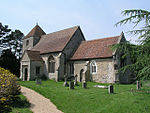Chrishall

Chrishall (pronounced Chris hall) is a small village in the English county of Essex. It is located 12 miles (20 km) south of Cambridge and lies equidistant [6 miles (10 km)] between the two medieval market towns of Saffron Walden and Royston. Although in Essex, Chrishall lies close to its borders with Hertfordshire and Cambridgeshire and has a 'Hertfordshire' postcode (SG8). The village was listed in the Domesday Book as Cristeshalla, or "nook of land dedicated to Christ". In 1422 (1 Henry VI), it appears in a record as "Cristeshale".The Icknield Way, a Neolithic track, passes through the parish. Chrishall's location is key to its character; as the village sits at the highest point in Essex, at 147 metres (482 ft) above sea level, road construction has avoided this high ground and therefore Chrishall is off the beaten track. Despite its relative isolation the village retains facilities such as a pre-school as well as a primary school. The village also boasts a sports field, a new playground, a church, a village hall and many clubs and societies as well as the Red Cow public house. Chrishall's population has remained largely unchanged over the last 170 years. In 1841 it totalled 518 and today about 450 people live in the village.Notable residents include the English composer, John Rutter.
Excerpt from the Wikipedia article Chrishall (License: CC BY-SA 3.0, Authors, Images).Chrishall
Church Road, Uttlesford
Geographical coordinates (GPS) Address Nearby Places Show on map
Geographical coordinates (GPS)
| Latitude | Longitude |
|---|---|
| N 52.032 ° | E 0.109 ° |
Address
Church Road
Church Road
SG8 8NP Uttlesford
England, United Kingdom
Open on Google Maps









